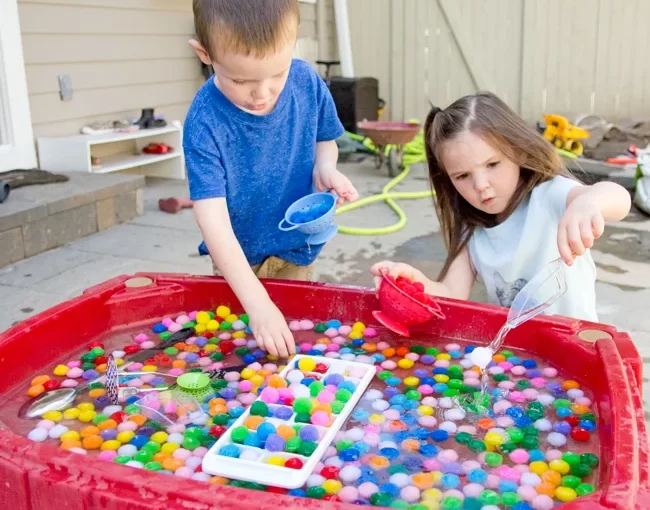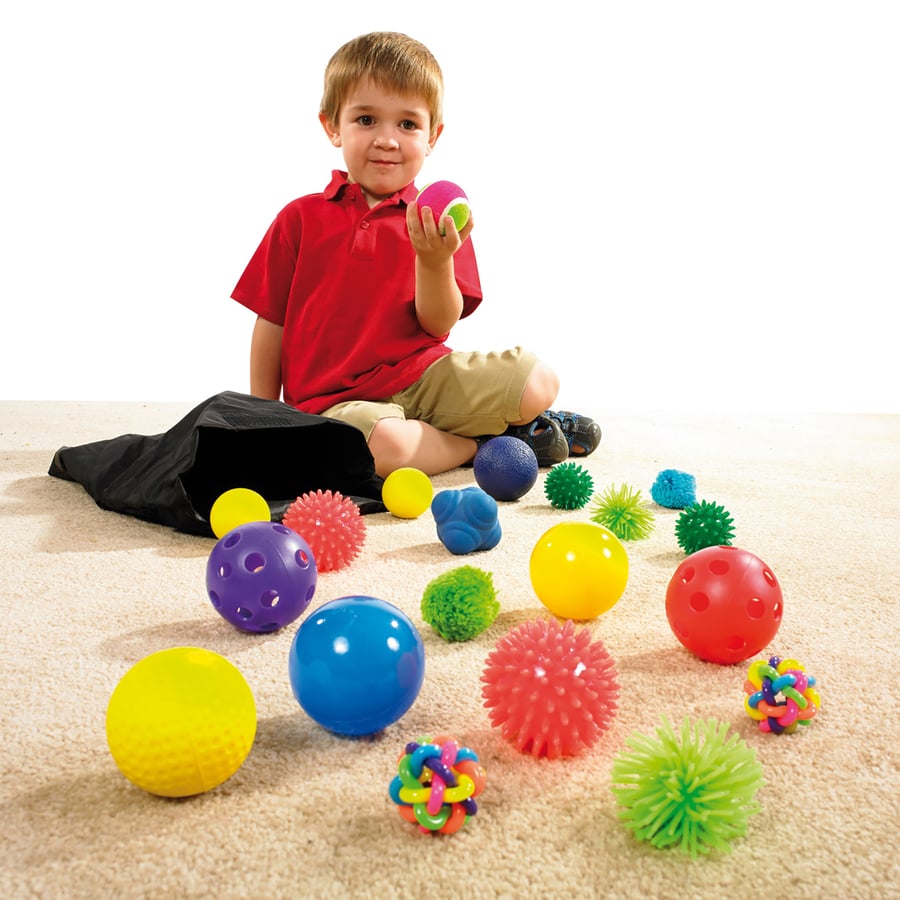Introduction to Sensory Ball Play
Sensory balls are not just ordinary toys; they are keys to developmental success for children of all ages. These balls come in various forms, each designed to stimulate different senses, fostering both fine and gross motor skills through tactile interaction and engaging play. From improving hand-eye coordination to enhancing cognitive responses, sensory balls offer a multitude of avenues for sensory development. They encourage exploration in a playful environment, allowing children to unconsciously learn as they engage with these dynamic tools. Perfect for home or educational environments, incorporating sensory ball activities can lead to significant advancements in a child’s physical and intellectual abilities.
The Role of Sensory Balls in Child Development
Sensory balls serve crucial roles in promoting childhood development. These innovative tools cater to kids at each developmental stage, promoting essential growth through sensory, motor, and cognitive engagement.
Benefits for Babies
For infants, sensory balls introduce new textures, sounds, and colors. They stimulate touch, hearing, and vision, important for brain development. Babies learn to grasp and manipulate these balls, improving their hand-eye coordination and sensory processing skills.
Advantages for Toddlers
As children start walking and exploring, sensory balls keep their little hands and minds engaged. Toddlers improve their gross motor skills by throwing, kicking, and chasing these balls. They practice balance and coordination while playing with sensory balls, which also help them understand cause and effect.
Importance for Preschoolers
Preschoolers benefit from more structured play with sensory balls. These activities refine their motor skills and enhance cognitive abilities like counting and color recognition. Sensory balls in group settings promote social skills, such as sharing and teamwork, vital for school readiness.
Significance for Elementary-Aged Children
For older kids, sensory balls are tools for complex skill enhancement. They aid in developing advanced motor skills and strategic thinking through sports or collaborative games. Sensory balls also encourage creativity and problem-solving, preparing children for academic challenges.
Types of Sensory Balls and Their Uses
Sensory balls come in many types with unique benefits for children’s development. They enhance sensory experiences and help kids learn through play. Below are some popular sensory ball options and how they can be used in activities for children of different ages.
Oball Classic and Textured Sets
The Oball Classic is a favorite among babies. It has holes that make it easy for tiny hands to grab. Textured sets offer varied sensations, aiding in tactile development. Use these balls for simple roll-and-grab games to improve motor skills.
Silicone-Textured Sensory Balls
These balls, made of silicone, have surfaces with different bumps and grooves. They’re great for touch-based learning and are usually safe for mouthing. Play can include squeezing and feeling the textures to boost sensory processing.
Sound and Light Stimulating Balls
Balls that rattle or light up when moved can catch a child’s attention. They stimulate hearing and sight. Use them to create interactive games where children can chase after the sounds or lights.
Montessori Fabric Puzzle Balls
Fabric puzzle balls are soft and often colorful. Their pieces encourage problem-solving and fine motor skills. They can be used in activities where children assemble or disassemble the ball, learning about shapes and structure.
Reflective Sensory Balls
These shiny balls reflect light and can fascinate children. They are useful for visual tracking exercises and can also be used in games that involve finding one’s reflection. It’s a unique way to explore light and symmetry.
Choosing the right sensory ball can make learning fun and cater to a child’s developmental needs. These balls are not just toys but tools that can greatly enhance a child’s play experience.
How to Determine if Your Child Needs Additional Stimulation
When it comes to child development, ensuring they receive the right amount of stimulation is crucial. It’s important to observe your child’s behavior for cues that they might need more sensory input than they’re currently getting. Here are some pointers to help you assess if additional stimulation could benefit your child.
Recognizing the Signs of Understimulation
Some children might show clear signs they’re not getting enough stimulation. Look for these symptoms:
- Lack of interest: Does your child seem disinterested in toys or activities?
- Restlessness: Is sitting still challenging for them?
- Fidgeting: Do they fidget or move about excessively?
- Low energy: Does your child appear tired or less engaged than usual?
- Development delays: Are they behind on developmental milestones?
- Emotional swings: Do they get frustrated or anxious easily?
If you notice several of these signs, consider offering more sensory-rich activities.
Understanding Overstimulation and Its Effects
Just as understimulation can impact your child, so can too much sensory input. Signs of overstimulation include:
- Irritability: Does your child get upset easily?
- Crying: Are they crying more than usual without an apparent reason?
- Trouble sleeping: Is falling or staying asleep difficult for them?
- Withdrawal: Does your child shun social interactions?
- Meltdowns: Do they have frequent tantrums or meltdowns?
If these behaviors are common, your child might be receiving too much stimulation. Adjusting their environment and activities to be less overwhelming can help.
Sensory balls can be a great tool to either increase or calm sensory experiences. They are versatile and can be adapted to match your child’s needs. By recognizing and responding to the signs of under or overstimulation, you provide the best support for your child’s development.
Creative Sensory Ball Activities
Engaging children in activities that utilize sensory balls can promote playful learning while supporting developmental skills across different ages.
Activities for Babies
Here are some simple, sensory-rich activities for babies:
- Roll sensory balls close to encourage crawling.
- Gently shake a textured ball to stimulate auditory senses.
- Place balls within reach for grasping and exploring textures.
Games for Toddlers
Toddlers learn through active play, so consider these games:
- Encourage kicking a ball to improve coordination.
- Play catch with a soft, light-up ball to develop motor skills.
- Hide balls for a fun find-and-seek game.
Engaging Preschoolers with Sensory Balls
Preschoolers are ready for more structured activities:
- Set up a mini obstacle course using balls to hone motor skills.
- Engage in a ball-rolling game to teach turn-taking.
- Use balls in color-matching activities to learn about colors.
Ideas for Elementary-Aged Kids
Older kids can handle complex play with sensory balls:
- Introduce ball-based relay races to boost teamwork.
- Use sensory balls for target practice, mixing physics with fun.
- Encourage creativity with an invent-your-own-game challenge using various sensory balls.
Incorporating these activities into your child’s playtime can provide stimulation that’s both fun and beneficial for their growth.
Integrating Sensory Balls with Other Educational Materials
Engaging with sensory balls can be enhanced by combining them with other learning tools.
Sensory Bins and Montessori Materials
Pairing sensory balls with materials like rice, beans, or sand engages multiple senses. This combination helps children learn textures, weights, and sounds. In Montessori settings, sensory balls complement other materials for holistic development.
Inclined Planes and Ramps
Using ramps or slides, children can roll sensory balls down. This teaches them about gravity, speed, and distance. It’s a playful way to introduce basic physics concepts.
Basket Sorting and Color Matching
These activities teach organization and color recognition. Give kids various colored balls and have them sort into matching baskets. It sharpens their ability to categorize and recognize colors.
Integrating sensory balls in these ways makes learning diverse and dynamic. It helps children develop fine motor skills, cognitive skills, and problem solving.
The Bottom Line on Sensory Balls in Play and Development
Sensory balls are more than just fun toys. They are vital in a child’s growth and learning. When kids play with these balls, they shape their senses and skills. For tiny tots, it’s about feeling new textures and hearing new sounds. Older kids kick, throw, and catch to get better at moving and thinking. Playtime with sensory balls is serious business for brain and body development.
Using different kinds, like soft fabric ones or shiny, light-reflective balls, makes learning diverse. Kids of all ages love the fun that comes with playing with these balls. It could be rolling them around or sorting them by color. This play is not just joy. It’s an adventure into touch, sight, and sound, leading to better skills in life.
So, sensory ball activities belong in every child’s play. They’re easy to mix with other learning tools, too. They help tap into a child’s natural curiosity and need to explore.
To sum it up, sensory balls should be a big part of playtime. They help kids learn and grow in exciting ways. Parents and teachers can use these toys to make every moment of play a stepping stone to the future.



